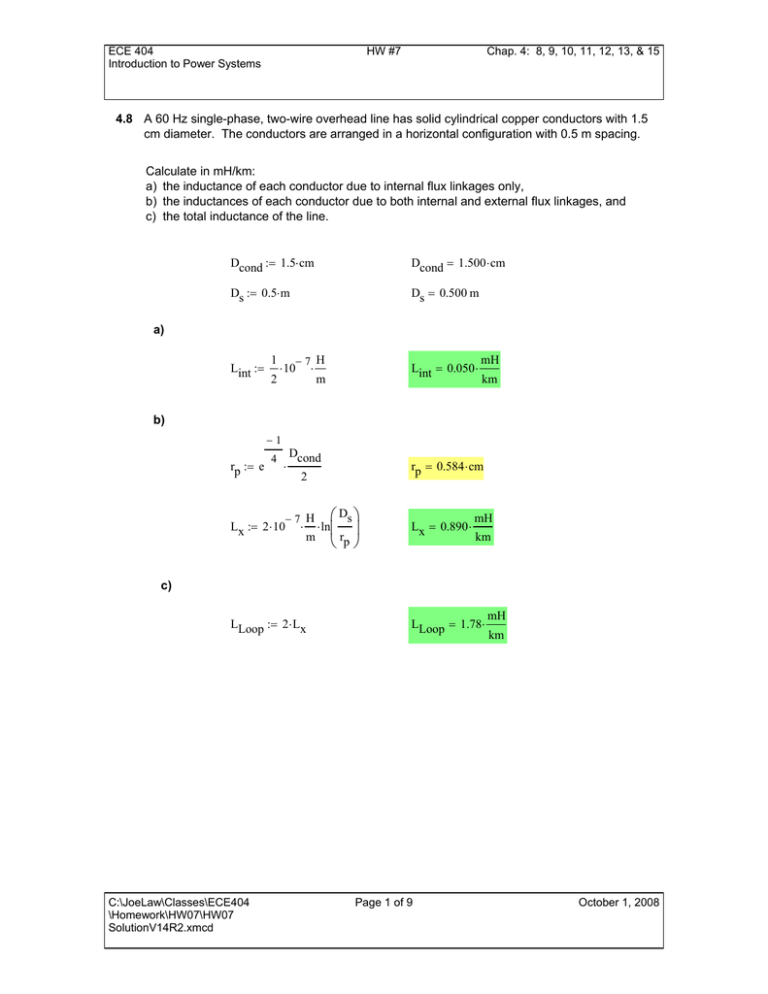HW #7
advertisement

ECE 404 Introduction to Power Systems HW #7 Chap. 4: 8, 9, 10, 11, 12, 13, & 15 4.8 A 60 Hz single-phase, two-wire overhead line has solid cylindrical copper conductors with 1.5 cm diameter. The conductors are arranged in a horizontal configuration with 0.5 m spacing. Calculate in mH/km: a) the inductance of each conductor due to internal flux linkages only, b) the inductances of each conductor due to both internal and external flux linkages, and c) the total inductance of the line. Dcond := 1.5⋅ cm Dcond = 1.500 ⋅ cm Ds := 0.5⋅ m Ds = 0.500 m a) Lint := 1 2 −7 H ⋅ 10 ⋅ Lint = 0.050 ⋅ m mH km b) −1 rp := e 4 ⋅ Lx := 2 ⋅ 10 Dcond rp = 0.584 ⋅ cm 2 ⎛ Ds ⎞ ⎟ m ⎝ rp ⎠ −7 H ⋅ ⋅ ln⎜ Lx = 0.890 ⋅ mH km c) LLoop := 2 ⋅ Lx C:\JoeLaw\Classes\ECE404 \Homework\HW07\HW07 SolutionV14R2.xmcd LLoop = 1.78⋅ Page 1 of 9 mH km October 1, 2008 ECE 404 Introduction to Power Systems HW #7 Chap. 4: 8, 9, 10, 11, 12, 13, & 15 4.9 Rework Problem 4.8 with the diameters of each conductor: a) increased by 20% to 1.8 cm, b) decreased by 20% to 1.2 cm, without changing the phase spacing. Compare the results with those of Problem 4.8. a) Dcondp20 := 1.2⋅ Dcond Lint := 1 2 Dcondp20 = 1.80⋅ cm −7 H ⋅ 10 ⋅ Lint = 0.050 ⋅ m mH Same km −1 rpp20 := e 4 ⋅ Dcondp20 2 ⎛ Ds ⎞ ⎟ m ⎝ rpp20 ⎠ −7 H Lxp20 := 2 ⋅ 10 Δp20 := ⋅ ⋅ ln⎜ Lxp20 − Lx C:\JoeLaw\Classes\ECE404 \Homework\HW07\HW07 SolutionV14R2.xmcd Lxp20 = 0.853 ⋅ Increased mH km Δp20 = −4.097 ⋅ % Lx LLoopp20 := 2 ⋅ Lxp20 ΔLoopp20 := rpp20 = 0.701 ⋅ cm LLoopp20 = 1.71⋅ LLoopp20 − LLoop LLoop Page 2 of 9 Decreased mH km ΔLoopp20 = −4.097 ⋅ % Decreased October 1, 2008 ECE 404 Introduction to Power Systems HW #7 Chap. 4: 8, 9, 10, 11, 12, 13, & 15 b) Dcondm20 := 0.8⋅ Dcond Lint := 1 2 −7 H ⋅ 10 ⋅ Dcondm20 = 1.20⋅ cm Lint = 0.050 ⋅ m mH Same km −1 rpm20 := e 4 ⋅ Dcondm20 2 ⎛ Ds ⎞ ⎟ m ⎝ rpm20 ⎠ −7 H Lxm20 := 2 ⋅ 10 Δm20 := ⋅ ⋅ ln⎜ Lxm20 − Lx Lx LLoopm20 := 2 ⋅ Lxm20 ΔLoopm20 := C:\JoeLaw\Classes\ECE404 \Homework\HW07\HW07 SolutionV14R2.xmcd LLoopm20 − LLoop LLoop Page 3 of 9 rpm20 = 0.467 ⋅ cm Lxm20 = 0.935 ⋅ decreased mH km Δm20 = 5.015 ⋅ % LLoopm20 = 1.87⋅ Increased mH km ΔLoopm20 = 5.015 ⋅ % Increased October 1, 2008 ECE 404 Introduction to Power Systems HW #7 Chap. 4: 8, 9, 10, 11, 12, 13, & 15 4.10 A 60 Hz three-phase, three-wire overhead line has solid cylindrical conductors arranged in the form of an equalateral triangle with 4 ft conductor spacing. Conductor diameter is 0.5 in. Calculate: a) the positive-sequence inductance in H/m and b) the positive-sequence reactance in ohms/km Dcond10 := 0.5⋅ in Dcond10 = 1.270 ⋅ cm Ds10 := 4 ⋅ ft Ds10 = 1.219 m a) −1 rp10 := e 4 ⋅ Dcond10 ⎛ Ds10 ⎞ ⎟ m ⎝ rp10 ⎠ −7 H Lps := 2 ⋅ 10 rp10 = 0.495 ⋅ cm 2 ⋅ −6 H ⋅ ln⎜ Lps = 1.10 × 10 Xps := 2 ⋅ π⋅ 60⋅ Hz⋅ Lps Ω Xps = 0.415 ⋅ km ⋅ m b) C:\JoeLaw\Classes\ECE404 \Homework\HW07\HW07 SolutionV14R2.xmcd Page 4 of 9 October 1, 2008 ECE 404 Introduction to Power Systems HW #7 Chap. 4: 8, 9, 10, 11, 12, 13, & 15 4.11 Rework Problem 4.10 with the spacing: a) increased by 20% to 4.8 ft and b) decreased by 20% to 3.2 ft. Compare the results with those of Problem 4.10. a) Dsp20 := 1.2⋅ 4 ⋅ ft Lpsp20 := 2 ⋅ 10 ΔLp20 := Dsp20 = 1.463 m ⎛ Dsp20 ⎞ ⎟ m ⎝ rp10 ⎠ −7 H ⋅ ⋅ ln⎜ Lpsp20 − Lps Lps Xpsp20 := 2 ⋅ π⋅ 60⋅ Hz⋅ Lpsp20 ΔXp20 := Xpsp20 − Xps Xps Lpsp20 = 1.14 × 10 −6 H ⋅ m ΔLp20 = 3.310 ⋅ % Increased Ω Xpsp20 = 0.429 ⋅ km ΔXp20 = 3.310 ⋅ % Increased b) Dsm20 := 0.8⋅ 4 ⋅ ft Lpsm20 := 2 ⋅ 10 ΔLm20 := Dsm20 = 0.975 m ⎛ Dsm20 ⎞ ⎟ m ⎝ rp10 ⎠ −7 H ⋅ ⋅ ln⎜ Lpsm20 − Lps Lps Xpsm20 := 2 ⋅ π⋅ 60⋅ Hz⋅ Lpsm20 ΔXm20 := C:\JoeLaw\Classes\ECE404 \Homework\HW07\HW07 SolutionV14R2.xmcd Xpsm20 − Xps Xps Page 5 of 9 Lpsm20 = 1.06 × 10 −6 H ΔLm20 = −4.052 ⋅ % ⋅ m Decreased Ω Xpsm20 = 0.398 ⋅ km ΔXm20 = −4.052 ⋅ % Decreased October 1, 2008 ECE 404 Introduction to Power Systems HW #7 Chap. 4: 8, 9, 10, 11, 12, 13, & 15 4.12 Calculate the inductive reactance per mile of a single-phase overhead transmission line operating at 60 Hz, given the conductors to be Partridge and the spacing between centers to be 20 ft. From Table A.4 L12 := 4 ⋅ 10 Ds12 = 6.10 m rp12 := 0.0217⋅ ft rp12 = 0.6614⋅ cm ⎛ Ds12 ⎞ ⎟ m ⎝ rp12 ⎠ −7 H ⋅ Ds12 := 20⋅ ft ⋅ ln⎜ L12 = 2.730 ⋅ mH km Ω X12 = 1.657 ⋅ mi X12 := 2 ⋅ π⋅ 60⋅ Hz⋅ L12 Note that Table A.4 gives a conductor diameter of 0.642 in. ⎛ 1⎞ ⎟ 4 0.642 ⋅ in e ⎝ ⎠⋅ = 0.635 ⋅ cm −⎜ 2 The corresponding radius does not yield the GMR given in the table. It is a stranded conductor! C:\JoeLaw\Classes\ECE404 \Homework\HW07\HW07 SolutionV14R2.xmcd Page 6 of 9 October 1, 2008 ECE 404 Introduction to Power Systems HW #7 Chap. 4: 8, 9, 10, 11, 12, 13, & 15 4.13 A single-phase overhead transmission line consists of two solid aluminum conductors having a radius of 2.5 cm, with a spacing of 3.6 m between centers. a) Determine the total line inductance in mH/m. b) Given the operating frequency of 60 Hz, find the total inductive reactance of the line in ohms/km and in ohms/mi. c) If the spacing is doubled to 7.2 m, how does the reactance change? rcond := 2.5⋅ cm rcond = 0.025 ⋅ m −1 rp13 := e 4 ⋅ rcond rp13 = 1.95⋅ cm a) Ds13 := 3.6⋅ m Ds13 = 3.600 m ⎛ Ds13 ⎞ ⎟ m ⎝ rp13 ⎠ −7 H Lp13 := 4 ⋅ 10 ⋅ − 3 mH ⋅ ln⎜ Lp13 = 2.09 × 10 ⋅ m b) Ω Xp13 = 0.787 ⋅ km Xp13 := 2 ⋅ π⋅ 60⋅ Hz⋅ Lp13 Ω Xp13 = 1.267 ⋅ mi c) Ds13c := 7.2⋅ m Lp13c := 4 ⋅ 10 Ds13c = 7.200 m ⎛ Ds13c ⎞ ⎟ m ⎝ rp13 ⎠ −7 H ⋅ ⋅ ln⎜ Xp13c := 2 ⋅ π⋅ 60⋅ Hz⋅ Lp13c ΔXp13 := C:\JoeLaw\Classes\ECE404 \Homework\HW07\HW07 SolutionV14R2.xmcd Xp13c − Xp13 Xp13 Lp13c = 2.37 × 10 − 3 mH ⋅ m Ω Xp13c = 0.892 ⋅ km ΔXp13 = 13.279⋅ % Page 7 of 9 Increases October 1, 2008 ECE 404 Introduction to Power Systems HW #7 Chap. 4: 8, 9, 10, 11, 12, 13, & 15 4.15 Calculate the GMR of a stranded conductor consisting of six outer strands surrounding and touching one central strand, all strands having the same radius r. 2R R := 1 D 4R R = 1.000 2R D ( 4⋅ R) − ( 2⋅ R) 2 D = 3.464 ⋅ R R 2R 2 D := 2R M := 7 −1 rp15 := e 4 ⋅R rp15 = 0.779 ⋅ R For the center strand. d 1, 1 d 1, 3 d 1, 6 := rp15 := d := d d 1, 2 1, 2 d 1, 4 1, 2 d 1, 7 := 2 ⋅ R := d := d d d 1, 2 1, 5 1, 2 := d = 2.000 ⋅ R 1, 2 1, 2 7 ∏ d1 , k P := 1 P = 49.843⋅ R 1 k= 1 For all of the six outer stands d 2, 1 d 2, 4 := 2 ⋅ R := D d d 2, 2 2, 5 := rp15 := 4 ⋅ R d 2, 3 d 2, 6 := 2 ⋅ R := D d 2, 7 := 2 ⋅ R 7 P := 2 ∏ d2 , k P = 299.060 ⋅ R 2 k= 1 n := 3 , 4 .. 7 C:\JoeLaw\Classes\ECE404 \Homework\HW07\HW07 SolutionV14R2.xmcd P := P n 2 Page 8 of 9 October 1, 2008 ECE 404 Introduction to Power Systems M HW #7 Chap. 4: 8, 9, 10, 11, 12, 13, & 15 2 M ∏ Pm GMR := GMR = 2.177 ⋅ R m= 1 OR 6 3 rp15 ⋅ ( 2 ⋅ R) = 49.843 2 rp15 ⋅ ( 2 ⋅ R) ⋅ ( 4 ⋅ R) ⋅ ( D) = 299.060 49 ⎡r ⋅ ( 2⋅ R) 6⎤ ⋅ ⎡r ⋅ ( 2⋅ R) 3⋅ ( 4⋅ R) ⋅ ( D) 2⎤ ⎣ p15 ⎦ ⎣ p15 ⎦ GMR2 := 6 GMR2 = 2.177 For fun and learning AactualCond := 7 ⋅ π⋅ R 2 AactualCond = 21.991⋅ R 2 Look at a Solid Conductor with the same GMR −1 GMR = e 4 ⋅ RsolidCond RsolidCond := GMR RsolidCond = 2.795 ⋅ R ⎛ − 1⎞ ⎜ 4 ⎟ ⎝e ⎠ AsolidCond := π⋅ RsolidCond 2 AsolidCond = 24.541⋅ R 2 A solid conductor with the same GMR would have to have a larger cross-sectional area; i.e., greater cost and heavier. AsolidCond − AactualCond AactualCond C:\JoeLaw\Classes\ECE404 \Homework\HW07\HW07 SolutionV14R2.xmcd = 11.6⋅ % Page 9 of 9 October 1, 2008



